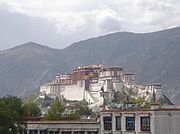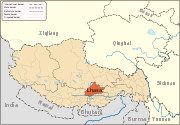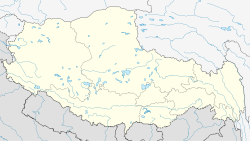- Negodong Nunnery
-
Negodong Nunnery Coordinates: 29°43′08″N 91°10′03″E / 29.71889°N 91.1675°E Monastery information Location Lhasa Prefecture, Tibet, China Founded 16th century. Became nunnery in the 1930s or 1940s. Type Tibetan Buddhist Colleges Part of Sera Monastery Coordinates Part of a series on Tibetan Buddhism
History Timeline · Related-topics Schools Nyingma · Kagyu · Sakya · Gelug · Bön · Jonang Key concepts Three marks of existence · Skandha · Cosmology · Saṃsāra · Rebirth · Bodhisattva · Dharma · Dependent origination · Karma Major figures Gautama Buddha · Padmasambhava · Je Tsongkhapa · Dalai Lama · Panchen Lama · Lama · Karmapa Lama · Rinpoche · Geshe · Terton · Tulku Buddhahood · Avalokiteśvara · Four stages of enlightenment · Tantric yoga · Paramitas · Meditation · Laity Changzhug · Drepung · Dzogchen · Ganden · Jokhang · Kumbum · Labrang · Mindroling · Namgyal · Narthang · Nechung · Pabonka · Palcho · Ralung · Ramoche · Sakya · Sanga · Sera · Shalu · Tashilhunpo · Tsurphu · Yerpa Chotrul Duchen · Dajyur · Losar · Monlam · Sho Dun Texts Kangyur · Tengyur · Tibetan canon · Mahayana sutras · Nyingma Gyubum Sand mandala · Thangka · Ashtamangala · Tree of physiology Outline · Comparative studies · Culture · List of topics · Portal
Negodong Nunnery is a historical hermitage, belonging to Sera Monastery. It is located in the northeastern Lhasa suburb known as Dodé Valley (Dog bde), northeast of Sera, Tibet. Buddhist scholar of the Sera Jé College’s (Grwa tshang byes) Gomdé Regional House (Sgom sde khang tshan), Nam mkha’ rgyal mtshan. It was initially founded as a monastery with seventeen monks but later allotted for exclusive use as nunnery to provide personal security to the nuns who were then residing in a remote nunnery at Gnas nang (higher valley to the east), away from the present location at Gnas sgo gdong (about an hour's walk).[1]
Contents
Geography
The nunnery situated in a mountainous landscape has assigned religious significance to each of the hills surrounding it. The black rocky mountain, in the shape of a triangle, to the east of the nunnery, is said to represent the protector deity of the nunnery, Lha mo nyi gzhon. This mountain is also credited as the “Three Great Mountains” (Ri chen gsum) on the periphery of Lhasa. The Northern boundary of the nunnery is known as the Soul-Mountain of Juniper Forests” (Shug pa’i nags bla ri), for the reason that juniper trees were in abundance here (higher slopes of the mountain still have some juniper trees). Two other hill peaks were used to hoist religious flags and to make burnt junifer offerings on the third day of the Tibetan New Year. The water sources sourced here are two springs with the names, the Ravine Spring (Grog mo chu mig) and the Sound-Catcher (or Ear) Spring (Sgra ’dzin chu mig) which are stated to have some curative properties.[2]
History
The known history of the place is linked to the Jé College’s (Grwa tshang byes) Gomdé Regional House (Sgom sde khang tshan), Nam mkha’rgyal mtshan (1532–1592) who built it initially as his retreat. Its conversion into a formal monastery is conjectured as some date in the eighteenth century, after the Mkhar rdo was founded an dit was founded with some seventeen monks initially. Its conversion into a nunnery is related to the security concerns expressed by the nuns who were the staying in a remote area called the Gnas nang. Their security concern was resolved by interchanging their home with that of the monks who were then staying at Gnas sgo gdong. This switch happened in the 1930s or early 1940s; however, the exact year is not clear. Concurrently, a Tibetan government’s money printing press (ngul gyi par khang) was also shifted from Dog bde and located close to the nunnery. However, the Khardo Lama’s estate bought the entire complex of buildings here resulting in creation of a larger estate facility, where the nuns were also housed. Following the creation of the larger facility as the Khardo Lama’s estate, the Tibetan Government intervened and impounded all the properties of the Rwa sgreng, the owner of the estate, due to some impropriety of a serious nature. Subsequently, the nuns were moved back to their original residence (which had been converted into a mansion). The Tibetan government thereafter, around 1949–50, demolished all the estate buildings, and then shifted the nuns to the printing press building.[3] After 1959,[when?] the nunnery was almost destroyed. However, a dedicated nun of the Negodong Nunnery went round the country seeking financial help to rebuild the nunnery, which is now seen rebuilt.[3]
The nunnery now functions as a practice centre (sgrub sde) along with Khardo Hermitage (Mkhar rdo ri khrod) and Gnas nang.[3]
Structure
The buildings of the nunnery complex comprise of two temples; the front one with a porch and another bigger one with an assembly room and a chapel to keep scriptures, known in Tibetan as 'Bka’ ’gyur lha khang'. A kitchen and a storage room were part of the complex. Nuns were provided with a dormitory, a three storied building, located behind the main temple. A reception room, an office room for the administrator (a senior nun), and a protector deity chapel form part of the main temple, all located on the second floor. More buildings have been built in recent years to the north east of the temple, which form the housing complex for the nuns and it has an adjunct chapel.[1]
Prior to 1959, the main idol, donated by the Seventh Dalai Lama Kelzang Gyatso (Da lai bla ma sku phreng bdun pa bskal bzang rgya mtsho), was that of Lokeshvara, which was carved out of sandalwood and crowned by an image of Padmasambhava. However, given that the previous monastery and its artefacts were largely destroyed, the idols are now new. Lha mo nyi ma gzhon is the protector deity of the nunnery.[1]
References
- ^ a b c "Negodong Hermitage (Gnas sgo gdong ri khrod)" (pdf). The Tibetan and Himalayan Library. http://www.thlib.org/places/monasteries/sera/hermitages/pdf/sera_herm_negodong.pdf. Retrieved 2010-03-03.
- ^ "Negodong Hermitage (Gnas sgo gdong ri khrod)". Location and layout. The Tibetan and Himalayan Library. http://www.thlib.org/places/monasteries/sera/essays/#essay=/cabezon/sera/herm/negodong/. Retrieved 2010-03-05.
- ^ a b c "Negodong Hermitage (Gnas sgo gdong ri khrod)". History. The Tibetan and Himalayan Library. http://www.thlib.org/places/monasteries/sera/essays/#essay=/cabezon/sera/herm/negodong/s/b2. Retrieved 2010-03-05.
External links
Lhünzhub · Damxung · Nyêmo · Qüxü · Doilungdêqên · Dagzê · Maizhokunggar · Chengguan District


Towns and villages Monasteries
and palacesArchitecture of Lhasa · Lingkhor · Potala Palace · Norbulingka · Jokhang Temple · Tsomon Ling · Ganden Monastery · · Kundeling Monastery · Nechung · Nyethang Drolma Lhakhang Temple · Yangpachen Monastery · · Drepung Monastery · Ramoche Temple · Reting Monastery · Sanga Monastery · Yerpa
Sera Monastery: · Chupzang Nunnery · Drakri Hermitage · Garu Nunnery · Jokpo Hermitage · Keutsang Hermitage · Keutsang East Hermitage · Keutsang West Hermitage · Khardo Hermitage · Negodong Nunnery · Nenang Nunnery · Pabongkha Hermitage · Panglung Hermitage · Purbuchok Hermitage · Rakhadrak Hermitage · Sera Chöding Hermitage · Sera Gönpasar Hermitage · Sera Utsé Hermitage · Takten Hermitage · Trashi Chöling HermitageOther landmarks Banak Shöl Hotel · Barkhor · Chokpori · Drapchi Prison · Lhasa Brewery · Lhasa Hotel · Lhasa Zhol Pillar · Tibet Museum · Tibet University · Tromzikhang · Nyang bran · Hutoushan ReservoirTransport Lhasa Airport · Damxung Railway Station · Lhasa Railway Station · Lhasa West Railway Station · Wumatang railway station · Yangbajain Railway Station · G109 · G318 · North Linkor RoadGovernment Doje Cezhug · Jigme Namgyal
Buddhist monasteries in Tibet Lhasa Prefecture Ani Tsankhung Nunnery · Drepung Monastery · Drigung Monastery · Ganden Monastery · Jokhang · Kundeling Monastery · Muru Nyingba Monastery · Namgyal Monastery · Nechung · Nyethang Drolma Lhakhang Temple · Ramoche Temple · Reting Monastery · Sanga Monastery · Taklung Yarthang Monastery · Tradruk Temple · Tsomon Ling · Tsurphu Monastery · Yangpachen Monastery · Yerpa · Zhuowaqudeng Monastery
Sera Monastery: · Chupzang Nunnery · Drakri Hermitage · Garu Nunnery · Jokpo Hermitage · Keutsang Hermitage · Keutsang East Hermitage · Keutsang West Hermitage · Khardo Hermitage · Negodong Nunnery · Nenang Nunnery · Pabongkha Hermitage · Panglung Hermitage · Purbuchok Hermitage · Rakhadrak Hermitage · Sera Chöding Hermitage · Sera Gönpasar Hermitage · Sera Utsé Hermitage · Takten Hermitage · Trashi Chöling HermitageShannan Prefecture Shigatse Prefecture Changmoche Monastery · Lhatse · Chokorgyel Monastery · Daklha Gampo · Dorje Pakmo · Drongtse Monastery · Donggar Monastery · Garju Monastery · Manmogang Monastery · Menri Monastery · Milarepa's Cave · Narthang Monastery · Ngor · Palcho Monastery · Ralung Monastery · Samding Monastery · Sakya Monastery · Ṣalu Monastery · Shelkar · Tashilhunpo · Tsi Nesar · Tsechen Monastery and DzongNgari Prefecture Chamdo Prefecture
and former KhamGalden Jampaling Monastery · Karma Gon Monastery · Benchen Monastery · Dorje Drak · Dzogchen Monastery · Dzongshar Monastery · Kandze Monastery · Katok Monastery · Nanwu Si Monastery · Palyul · Riwoche Monastery · Shechen Monastery · Surmang · Tongkor ·Nyingchi Prefecture Categories:- Sera Monastery
- Buddhist nunneries in Tibet
- Lhasa Prefecture
Wikimedia Foundation. 2010.


